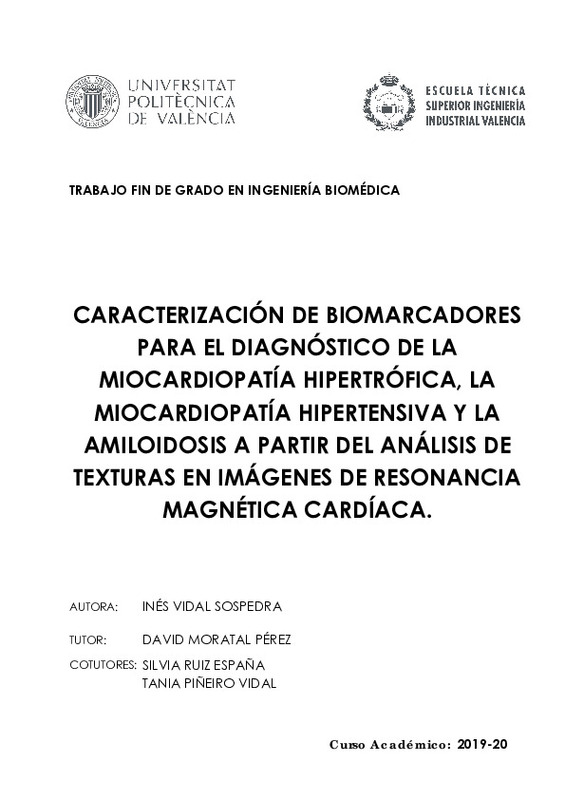|
Resumen:
|
[ES] En la actualidad, las enfermedades cardiovasculares son una de las principales causas de muerte en todo el mundo. Por ello, cada vez es más necesario el desarrollo de nuevos métodos de diagnóstico que aporten información ...[+]
[ES] En la actualidad, las enfermedades cardiovasculares son una de las principales causas de muerte en todo el mundo. Por ello, cada vez es más necesario el desarrollo de nuevos métodos de diagnóstico que aporten información adicional al médico y que permitan diagnosticar adecuadamente estas patologías, así como seleccionar el tratamiento más adecuado.
En este trabajo se pretende desarrollar un biomarcador para el diagnóstico de la miocardiopatía hipertrófica, la miocardiopatía hipertensiva y la amiloidosis. Estas tres patologías presentan un cuadro clínico similar ya que todas ellas están caracterizadas por un engrosamiento anormal del miocardio. Por todo esto, el objetivo principal sería poder diferenciar entre estas tres patologías a partir del análisis de texturas en imagen de resonancia magnética cardíaca, lo que supondría un nuevo método no invasivo de gran interés.
Inicialmente, a partir de secuencias cine de imágenes de resonancia magnética cardíaca en eje corto de pacientes con las diferentes patologías, se segmentará la zona de interés utilizando el software Segment de Medviso. El estudio se realizará en dos partes; primero con 50 sujetos de las patologías miocardiopatía hipertensiva y miocardiopatía hipertrófica y, segundo, debido a que la amiloidosis es una enfermedad poco frecuente, se reducirá el número de sujetos a 15 y se considerarán las tres patologías.
Una vez segmentadas todas las imágenes y preprocesadas las regiones de interés, se extraerán 43 características de texturas utilizando métodos estadísticos para diferentes niveles de gris (16, 32, 64, 128 y 256). A continuación, haciendo uso de algoritmos de aprendizaje máquina, se procederá a la creación de un modelo predictivo. Para ello, se estudiará tanto la clasificación binaria como la multiclase, analizando por un lado las dos patologías con más sujetos y, por otro lado, las tres con un número de pacientes inferior. Además, se desarrollarán diferentes modelos y se analizarán los resultados obtenidos en términos de precisión para llegar a definir finalmente cual es el que, en conjunto con los métodos de selección de características proporciona una mejor discriminación entre las tres patologías que se están analizando. Se empleará el entorno científico MATLAB.
[-]
[EN] Nowadays, cardiovascular disease is one of the leading causes of death worldwide. Therefore, the development of new diagnostic methods that provide additional information to the doctor and that allow to properly ...[+]
[EN] Nowadays, cardiovascular disease is one of the leading causes of death worldwide. Therefore, the development of new diagnostic methods that provide additional information to the doctor and that allow to properly diagnose these pathologies, as well as select the most appropriate treatment.
This work aims to develop a biomarker for the diagnosis of hypertrophic cardiomyopathy, hypertensive cardiomyopathy and amyloidosis. These three pathologies have a similar clinical appearance as they are all characterized by abnormal thickening of the myocardium. For all this, the main objective would be to be able to differentiate between these three pathologies from the analysis of textures in cardiac magnetic resonance imaging (cardiac MRI), which would mean a new non-invasive method of great interest.
Initially, from short-axis cardiac MRI cinema sequences of patients with different pathologies, the area of interest will be segmented using Medviso's Segment software. The study will be carried out in two parts; firstly with 50 subjects of hypertensive cardiomyopathy pathologies and hypertrophic cardiomyopathy and, secondly, because amyloidosis is a rare disease, the number of subjects will be reduced to 15 and all three pathologies will be considered.
Once all images have been segmented and the regions of interest pre-processed, 43 texture characteristics will be extracted using statistical methods for different grey levels (16, 32, 64, 128 and 256). Then, using machine learning algorithms, a predictive model will be created. To this end, both binary and multiclass classification will be studied, analysing on the one hand the two pathologies with more subjects and, on the other hand, the three with a lower number of patients. In addition, different models will be developed, and the results obtained will be analysed in terms of precision in order to finally define which is which, together with the methods of selection of characteristics provides a better discrimination between the three pathologies that are being analysed. The MATLAB scientific environment shall be used.
[-]
|







